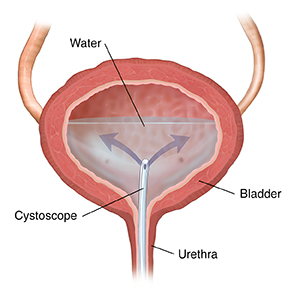Understanding Hydrodistention with Cystoscopy
Hydrodistention is a procedure that fills up your bladder with water. It is used to help find out what may be causing your bladder pain. During the procedure, a long, thin tube (cystoscope) is used. It has a lens and a light on one end. This tube helps your healthcare provider see inside your bladder. It is put into your bladder through your urethra. That’s the tube that passes urine out of your body.

How to say it
HI-droh-dihs-TEHN-shuhn sihs-TAHS-kuh-pee
Why hydrodistention with cystoscopy is done
This procedure is done to figure out the cause of bladder pain. It may help diagnose bladder pain syndrome (BPS), also called interstitial cystitis (IC). If you have this health problem, you may feel pain when your bladder fills with urine. You may also need to pass urine more often.
This procedure is also sometimes done to treat BPS. It may be tried if other treatments, such as medicine, don’t work.
How hydrodistention with cystoscopy is done
This may be done in a hospital or at an outpatient facility. During the procedure:
-
You are given medicine so you won’t feel any pain. It may also make you fall asleep.
-
Your healthcare provider puts the cystoscope into your urethra. They gently move it forward into your bladder.
-
Using the cystoscope, they slowly fill up your bladder with as much water as possible. This helps find out how much fluid your bladder can hold.
-
Your bladder is then drained and filled again.
-
Your healthcare provider may look at your bladder lining with the cystoscope. They will see if there are any sores or other possible causes for your symptoms.
-
Your bladder is drained.
Risks of hydrodistention with cystoscopy
All procedures have risks. Some possible risks of this procedure include:
-
Infection
-
Blood in urine
-
Symptoms get worse
Online Medical Reviewer:
Raymond Kent Turley BSN MSN RN
Online Medical Reviewer:
Rita Sather RN
Online Medical Reviewer:
Sabrina Felson MD
Date Last Reviewed:
7/1/2023
© 2000-2024 The StayWell Company, LLC. All rights reserved. This information is not intended as a substitute for professional medical care. Always follow your healthcare professional's instructions.